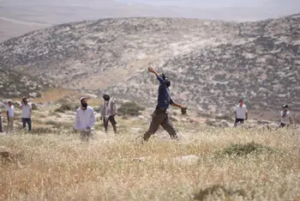When my daughter was a newborn, I read an essay about a toddler who died after a loose brick fell from a building onto her head. Devastatingly random, impossible to parse for meaning. I added loose brick to the litany of ways my baby could die.
The list was ever-expanding. When I sat with her in the bathtub at night as she fed from my breast, I imagined falling asleep, both of us sliding down into the warmth. When I swaddled her and lay her on her back in her bassinet, I imagined her hummingbird heart stopping between one breath and the next. When my husband or I strapped her into the car seat, I imagined being T-boned at an intersection. Struck by a drunk driver. Rammed by an 18-wheeler on the highway. I imagined the car seat sailing beyond the reach of my crushed fingers.
I know now that these are called intrusive thoughts, and that I was probably suffering from undiagnosed postpartum anxiety. I believe this because I didn’t experience it with my second child, though he was born in the first year of the pandemic and heightened anxiety was arguably more justified. At the time, though, I thought this terror—tucked behind euphoric new love and relentless daily care—was simply what it meant to be a mother, driven by instinct and desire to protect vulnerable offspring from a world where a loose brick, unthinking, unfeeling, could simply fall.
In 2020, guns became the leading cause of death for children and teens in the U.S.
Notifications roll across my phone: teens and young adults injured or killed for ringing the wrong doorbell, pulling up at the wrong house, entering the wrong car, and standing in the bullpen during a baseball game. Teens killed or injured in mass shootings at parks and parties celebrating prom and Sweet 16. Five members of a family, including a 9-year-old boy, massacred in their own home by a neighbor whom they asked to stop shooting in his yard because their newborn was trying to sleep. Five calls to the police, and no help came. Then the neighbor reloaded. He ran toward their house, where the husband told his wife to get inside. “He won’t fire at me, I’m a woman,” she said. She was the first to die. Two other women were found lying dead on top of her baby and 2-year-old they were protecting. The children, alive, covered in the women’s blood.
All of this, within the last month.
As I was writing this essay over the weekend, I wondered what would surpass this horror in our collective memory. What would make us forget the young boy picking up his twin brothers, the cheerleader, the 9-year-old, the weight and heat and blood of three women whose final actions were to put their bodies between a bullet and the children they loved?
I was shopping for a child’s birthday gift at Target when my husband texted: his brother had called from Australia, where my husband is from, to ask if we were OK. My husband said yes; why? My brother-in-law had heard, somehow before we did, of the massacre at Allen Premium Outlets, which left nine dead, including the shooter, and wounded seven more, including children as young as 5—the same age as our daughter. My brother-in-law remembered an outlet mall we’d taken him to on a visit once. He couldn’t remember the name of the small town. It could have been there, he thought. It could have been us.
It’s not the first time our Australian family has called, nearly frantic, worried one or all of us had been shot to death. They called last month when they heard a Texas family had been executed by their neighbor. They called last year when they heard a gunman killed 19 children and 2 teachers at an elementary schoolnear San Antonio, where we live. This was Robb Elementary in Uvalde, where three friends of a friend lost their 9-year-old daughters. How? they ask. How can this keep happening? How can we keep letting it?
In 2021, an estimated 1.6 million firearms were sold in Texas, more than anywhere else in the nation. Gun laws keep loosening and gun deaths keep rising. According to the CDC, Texas’s gun death rate per capita was 15.6 per 100,000 residents in 2021, compared to 10.7 in 2014. More Texans were killed by guns that year than in car accidents. And we’re not even close to the deadliest state in the nation for gun deaths—that’s Mississippi, at 33.9 per 100,000. (Massachusetts is the lowest at 3.4.) According to the Pew Research Center, 48,830 people died of gun violence in the U.S. in 2021, more than any other year on record. So far this year, the Gun Violence Archive reports, 14,711 people have died of gun violence in the U.S., with 202 mass shootings and counting.
An incomplete list of where I’ve imagined my children being shot to death:
- Their classrooms, bodies splayed on foam mats beneath laminated handprint ducklings
- Target, where I always remind myself of entrances and exits, the aisle with laundry hampers where I could hide them
- A restaurant, where I imagine that we might be able to tip a table over, use it as a shield, but so many tables are fixed in place, and if wood could protect us, people wouldn’t get shot through doors
- A movie theater, the kind my parents took us to every week as a kids, one of our most beloved family outings but where now I think: sitting ducks
- Parades, which we don’t go to anyway, so maybe I can cross this one off the list, for now
- Later: prom, parties, bars, college, office buildings, banks, hospitals, convenience stores, any place people gather in the course of their beautiful, ordinary lives
Are these intrusive thoughts? Or are they simply thoughts, fearful but reasonable, considering we live in America?
The night of the Allen Premium Outlets shooting, I comb Twitter for updates. Videos are circulating. One, from the dashcam of a car leaving the parking lot, shows the shooter emerging from a silver sedan and opening fire. A jacked-up pickup peels out of its parking space, veering away. The comments are on fire with people saying the driver should have turned toward the shooter, mowed him down. Everyone thinks they’d be a hero in this situation.
Another video, graphic. I know what I’m about to see, but I watch anyway. I don’t know why. To bear witness, maybe. That feels important. When my husband walks into the bedroom, I tell him I watched the video. “Oh, baby,” he says. “Oh, no. Everyone on Reddit is saying to avoid Twitter. I was going to tell you—there’s a kid—did you see the kid?” I nod and he holds me as I sob.

People pray at a memorial next to the Allen Premium Outlets in Allen, Texas, on May 7, 2023.
Joe Raedle—Getty Images
The next morning, I take our kids to a birthday party. A massive indoor playground, their faces wild with joy. They spin on foam teacups, jump on trampolines, scramble through netted tunnels, fly down a slide. I laugh and wave, help my toddler when he needs it, give him space when he doesn’t.
There is always a tension between what we know about the world and what our kids know. My kids don’t know our worry—no, our terror. They know school and birthday parties and picking flowers and “Can I get a toy?” They don’t know about guns, not really. They don’t know people kill each other. They don’t know adults kill children. My daughter doesn’t know that in three years, when she’s in third grade, a proposed Texas bill would require her to learn to use bleeding control stations to stop a bleed during school shootings. (Currently, state law only—“only”—requires seventh graders and above to know how to use these stations.)
At the party, our children play and we mothers talk. One tells us about the new bulletproof glass installed at her child’s school. Another says her kids have never been to a mall. Most of us grew up in houses with guns. Most of our husbands own guns. We don’t feel safe. None of us feel safe. None of us feel free. We make ourselves numb, stop looking at the news, draw our lines in the sand and make our concessions to normalcy, and we pretend that every step into a public space in America isn’t a leap of faith.
After the party, once the kids are full of cake and ice cream and my toddler is down for his nap, I look for updates on the Allen shooting. There’s an interviewwith a witness who arrived at the victims before the first responders. He describes seeing a girl—not a woman, a girl—crouched down, covering her head in the bushes. He felt for a pulse, turned her around, and “she had no face.” He describes finding a child beneath the body of his dead mother, whose blood soaked him head to toe. I can’t believe this is the second time in nine days I’m reading this description.
Sometimes I wonder what wars we wouldn’t wage if another country were murdering nearly 50,000 Americans a year. But the bloodshed comes from within our borders, so we let it. We are a snake eating its own tail. We unlock our jaw and open wide.
More Must-Reads From TIME
- Trump Found Liable for Sexual Abuse, Defamation
- The Terror of Raising Children in America: Column
- Is Your Work Stress Burnout? A Quiz
- Tina Brown on King Charles III
- How the Writers Strike Could Impact TV Shows That Are Still Filming
- The Hidden Role Ordinary Iranians Have Played in the Protests
- Private Security Guards Are Replacing Police Across America
- Succession’s ‘Tailgate Party’ Is a Tale of Two Toxic Marriages
- Why the U.S. May Be Days Away From Another Border Crisis
Contact us at letters@time.com.




